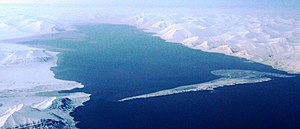Akseløya
| Akseløya | ||
|---|---|---|
| Van Mijenfjord with Akseløya | ||
| Waters | Van Mijenfjord , Greenland Sea | |
| Archipelago | Spitsbergen | |
| Geographical location | 77 ° 42 '59 " N , 14 ° 40' 53" E | |
|
|
||
| length | 8.4 km | |
| width | 960 m | |
| surface | 4 km² | |
| Highest elevation | Flinthaugen 60 m |
|
| Residents | uninhabited | |
Akseløya is an uninhabited island in the Norway- administered Svalbard Archipelago .
geography
The elongated island is located at the mouth of the Van Mijenfjord in the Bellsund and, together with the offshore island of Mariaholm, almost completely blocks it. Only north of Akseløya and south of Mariaholm there are narrow passages with the Akselsund and the Mariasund. The Vernskjera archipelago lies in front of the island to the west. The anchorage protected by this is called Akselhamna. The northern and southern tips of Alseløya are named after Norwegian scientists Birkelandodden and Russeltvedtodden. The highest point is the Flinthaugen with a height of about 60 meters above sea level. The Akseløya light (L 4304), a steel frame with a fire height of 15 m, is located on the northern tip of the island as a navigation aid for ship traffic through Akselsund .
Akseløya consists of steeply upright sediment layers from the Permo - Carboniferous , which are weathered to form ribs. To the east are layers from the Triassic , which merge into marine terraces from the Holocene .
history
The island bears its name in memory of the schooner Aksel Thordsen , the ship of the Swedish Svalbard expedition in 1864 under the direction of Adolf Erik Nordenskiöld .
Johan Hagerup (1846–1924) built a trapper's hut in 1898, the Hageruphuset, on the southern tip of Akseløya. It was used by Norwegian fur hunters in the winters of 1898/99, 1900/01, 1904/05 and 1906/07. In the winter of 1904/05 alone, 20 polar bears, 42 blue and 64 white arctic foxes , 207 bearded seals and 120 reindeer were killed and 594 kg of eiderdown were collected. In 1902/03 the hut served as a residence for the Norwegian Northern Lights Expedition organized by Kristian Birkeland . The meteorologist Nils Russeltvedt (1875–1946) and the electrical engineer H. Hagerup made observations of the Earth's magnetic field at the same time as they did three other stations in Northern Norway, Iceland and Nowaja Zemlya . Two more small huts and a storage shed were built for their instruments. Today only remains of the foundations of these buildings remain. Also from the main house there were only remnants of the wall until it was restored in 1993. Today it is considered the oldest preserved hunting lodge in Spitzbergen.
Individual evidence
- ↑ Akseløya . In: The Place Names of Svalbard (first edition 1942). Norsk Polarinstitutt , Oslo 2001, ISBN 82-90307-82-9 (English, Norwegian).
- ^ List of Lights, Radio Aids and Fog Signals. Pub. 115 - Norway, Iceland and Arctic Ocean (PDF; 2.66 MB), National Geospatial-Intelligence Agency, Springfield, Virginia, 2016, p. 274 (English)
- ↑ Gerhard Stäblein: The polar permafrost and the thawing layer in Svalbard (PDF; 679 kB). In: Polarforschung Vol. 41, No. 1-2, 1971, pp. 112-120
- ↑ a b Gustav Rossnes: Norsk Overvintringsfangst o på Svalbard 1895–1940 (PDF; 7.7 MB), Norsk Polarinstitutt Meddelser No. 127, Norsk Polarinstitutt, Oslo 1993, p. 51 (Norwegian)
- ↑ a b Hageruphuset . In: The Place Names of Svalbard (first edition 1942). Norsk Polarinstitutt , Oslo 2001, ISBN 82-90307-82-9 (English, Norwegian).
- ↑ Odd Lønø: Norske fangstmenns overvintringer , part 3: 1892–1905 (PDF; 2.9 MB), Norsk Polarinstitutt Meddelser No. 105, Norsk Polarinstitutt, Oslo 1976, p. 126 (Norwegian)
- ↑ Kristian Birkeland: The Norwegian aurora polaris Expedition 1902-1903 , Volume 1, Aschehoug, Christiania 1908, p. 24 ff.
- ↑ Irene Skauen Sandodden: Catalog prioritized kulturminner og kulturmiljøer på Svalbard (PDF; 5.3 MB), Version 1.1, 2013, p. 164 (Norwegian)

